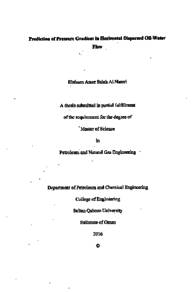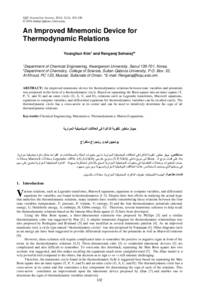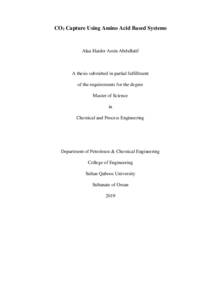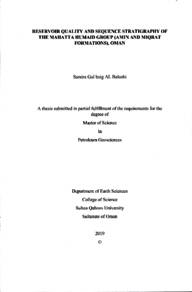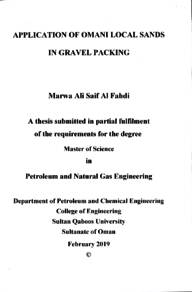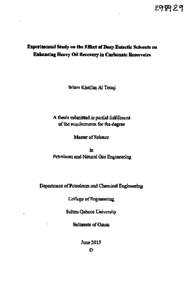وثيقة
Prediction of pressure gradient in horizontal dispersed oil-water flow
الناشر
Sultan Qaboos University
ميلادي
2016
اللغة
الأنجليزية
الملخص الإنجليزي
The purpose of this thesis is to improve the prediction of pressure gradient in dispersed oil-water flow in horizontal pipes. The homogeneous model is commonly used for predicting the pressure gradient where the mixture of oil and water is treated as a pseudo-single fluid. The prediction of the pressure gradient using the homogenous model can be improved by either improving and/or developing new correlations for friction factor and mixture viscosity. Currently, large numbers of friction factor and viscosity correlations are available in the literature. In this study, the performances of these correlations were evaluated against 484 experimental pressure gradient data points using statistical error parameters: average percent error, APE, absolute average percent error, AAPE and standard deviation SD. These data were collected from 10 different sources and covered wide range of pipe diameters, oil viscosities, densities and pipe materials. The comparisons revealed that the performances of all the friction factor correlations in predicting pressure gradient are generally the same. On the other hand, the performances of the viscosity correlations in predicting the pressure gradient are very different. Taylor, Pal and Rhodes, Einstein and Pal (Eq. 16) viscosity correlations gave better prediction in comparison to the other correlations with AAPE of 25%. The worst prediction was obtained using Yaron and Gal-Or and Al-Sarkhi correlations with AAPE of 37% and 35% respectively.
The influence of pipe diameter, pipe material and oil viscosity on the prediction of the pressure gradient was also investigated. It was found that the error in predicting the pressure gradient increases as the pipe diameter increases and decreases as the oil viscosity increases. The effect of pipe material was also examined using acrylic and steel pipe. Pressure gradient in steel pipe is slightly higher than that of acrylic pipe.
An attempt was also made to improve the prediction of pressure gradient in horizontal dispersed oil-water flow. Blasius and Hinze friction factor was modified by considering all system parameters that may affect the friction factor. The improved correlations were able to better predict the pressure gradient with AAPE of 22%. All the system parameters that may affect the mixture viscosity were also considered and a simple viscosity correlation was developed. The new proposed viscosity correlation outperformed the existing correlations when used to predict the pressure gradient with AAPE of 21%.
المجموعة
URL المصدر
الملخص العربي
يهدف هذا البحث إلى تحقيق أفضل تنبؤ الفرق الضغط في سريان مزيج النفط والماء في الأنابيب الأفقية، حيث تم استخدام معادلة فرق الضغط للخليط المتجانس لحساب فرق الضغط في سريان مزيج النفط والماء على اعتبارهما مزيج متجانسة، كما أنه يتم تحسين التنبؤ بالضغط عن طريق تطوير المعادلات المتوفرة أو إنشاء معادلات جديدة الحساب معامل الاحتكاك واللزوجة، بالرجوع للدراسات السابقة تم تجميع العديد من معادلات الاحتكاك واللزوجة،
هذه المعادلات تم صياغتها على أساس البيانات التي تم تجميعها وفي ظروف محددة مثل قطر الأنبوب، نوع مادة الأنبوب، لزوجة وكثافة النفط لتعطي أفضل تنبؤ بفرق الضغط ، تكمن المشكلة عند استخدام هذه المعادلات في ظروف مختلفة حيث تعطي نتائج مختلفة لفرق الضغط مقارنة بالنتائج المعملية التي تم استخراجها من التجارب، ومن هنا لابد من المقارنة بين هذه المعادلات لاختيار الأفضل في حساب فرق الضغط في هذا البحث تم جمع بيانات الفرق الضغط من التجارب السابقة حيث تشمل 484 نقطة من 10 مصادر مختلفة، هذه البيانات تشمل مجموعة واسعة من أقطار الأنابيب، مادة الأنابيب، كثافة ولزوجة النفط وتم استخدام ثلاثة معايير ( APE ,
AAPE , SD ) للتقييم والمقارنة بين هذه المعادلات، حيث أظهرت نتائج المقارنات أن جميع معادلات معامل الإحتكاك لها نفس الكفاءة في التنبؤ بفرق الضغط ، من ناحية أخرى اختلفت كفاءة معادلات اللزوجة في التنبؤ بفرق الضغط حيث تعتبر تايلور، بال وروس، اينشتاين وبال (معادلة. 16) الأفضل مقارنة بالمعادلات الأخرى ، بينما اعلى نسبة الخطا في عدم التوافق بين النتائج المعملية والمتوقعة رياضية للزوجة تم الحصول عليها باستخدام معادلات پارون وغال- أو و الصارخی أيضا تم دراسة تأثير قطر الأنبوب، مادة الأنبوب ولزوجة النفط في التنبؤ بفرق الضغط وأظهرت النتائج أن قطر الأنبوب له التأثير الأكبر في التنبؤ بفرق الضغط حيث يرتفع الضغط كل ما قل قطر الأنبوب ، ايضأ لوحظ ارتفاع فرق الضغط في أنابيب الصلب أو الحديد مقارنة بأنابيب الأكريلك، كما أن فرق الضغط يتأثر بلزوجة النفط حيث أنه يرتفع بزيادة لزوجة النفط ، ايضا هذه العوامل لها تأثير في دقة حساب فرق الضغط کرست جهود كبيره في محاولة لتحسين التنبؤ بفرق الضغط حيث أنه تم تطوير معادلات معامل الاحتكاك وذلك باعتبار جميع المتغيرات التي من شأنها أن تساهم في التأثير في التنبؤ بفرق الضغط حيث أن معادلات معامل الاحتكاك المطورة لها القدرة على التنبؤ بفرق الضغط بدقة أكبر من المعادلات السابقة ، ايضا تم صياغة معادلة الحساب اللزوجة لمزيج النفط والماء وتم اعتبار جميع المتغيرات التي تؤثر على الزوجة المزيج، حيث تم مقارنة هذه المعادلة بمعادلات اللزوجة المتوفرة في الدراسات السابقة، وأظهرت نتائج المقارنة أن المعادلة الحالية أفضل من حيث الكفاءة في التنبؤ بفرق الضغط مقارنة بالمعادلات الأخرى.
هذه المعادلات تم صياغتها على أساس البيانات التي تم تجميعها وفي ظروف محددة مثل قطر الأنبوب، نوع مادة الأنبوب، لزوجة وكثافة النفط لتعطي أفضل تنبؤ بفرق الضغط ، تكمن المشكلة عند استخدام هذه المعادلات في ظروف مختلفة حيث تعطي نتائج مختلفة لفرق الضغط مقارنة بالنتائج المعملية التي تم استخراجها من التجارب، ومن هنا لابد من المقارنة بين هذه المعادلات لاختيار الأفضل في حساب فرق الضغط في هذا البحث تم جمع بيانات الفرق الضغط من التجارب السابقة حيث تشمل 484 نقطة من 10 مصادر مختلفة، هذه البيانات تشمل مجموعة واسعة من أقطار الأنابيب، مادة الأنابيب، كثافة ولزوجة النفط وتم استخدام ثلاثة معايير ( APE ,
AAPE , SD ) للتقييم والمقارنة بين هذه المعادلات، حيث أظهرت نتائج المقارنات أن جميع معادلات معامل الإحتكاك لها نفس الكفاءة في التنبؤ بفرق الضغط ، من ناحية أخرى اختلفت كفاءة معادلات اللزوجة في التنبؤ بفرق الضغط حيث تعتبر تايلور، بال وروس، اينشتاين وبال (معادلة. 16) الأفضل مقارنة بالمعادلات الأخرى ، بينما اعلى نسبة الخطا في عدم التوافق بين النتائج المعملية والمتوقعة رياضية للزوجة تم الحصول عليها باستخدام معادلات پارون وغال- أو و الصارخی أيضا تم دراسة تأثير قطر الأنبوب، مادة الأنبوب ولزوجة النفط في التنبؤ بفرق الضغط وأظهرت النتائج أن قطر الأنبوب له التأثير الأكبر في التنبؤ بفرق الضغط حيث يرتفع الضغط كل ما قل قطر الأنبوب ، ايضأ لوحظ ارتفاع فرق الضغط في أنابيب الصلب أو الحديد مقارنة بأنابيب الأكريلك، كما أن فرق الضغط يتأثر بلزوجة النفط حيث أنه يرتفع بزيادة لزوجة النفط ، ايضا هذه العوامل لها تأثير في دقة حساب فرق الضغط کرست جهود كبيره في محاولة لتحسين التنبؤ بفرق الضغط حيث أنه تم تطوير معادلات معامل الاحتكاك وذلك باعتبار جميع المتغيرات التي من شأنها أن تساهم في التأثير في التنبؤ بفرق الضغط حيث أن معادلات معامل الاحتكاك المطورة لها القدرة على التنبؤ بفرق الضغط بدقة أكبر من المعادلات السابقة ، ايضا تم صياغة معادلة الحساب اللزوجة لمزيج النفط والماء وتم اعتبار جميع المتغيرات التي تؤثر على الزوجة المزيج، حيث تم مقارنة هذه المعادلة بمعادلات اللزوجة المتوفرة في الدراسات السابقة، وأظهرت نتائج المقارنة أن المعادلة الحالية أفضل من حيث الكفاءة في التنبؤ بفرق الضغط مقارنة بالمعادلات الأخرى.
قالب العنصر
الرسائل والأطروحات الجامعية

